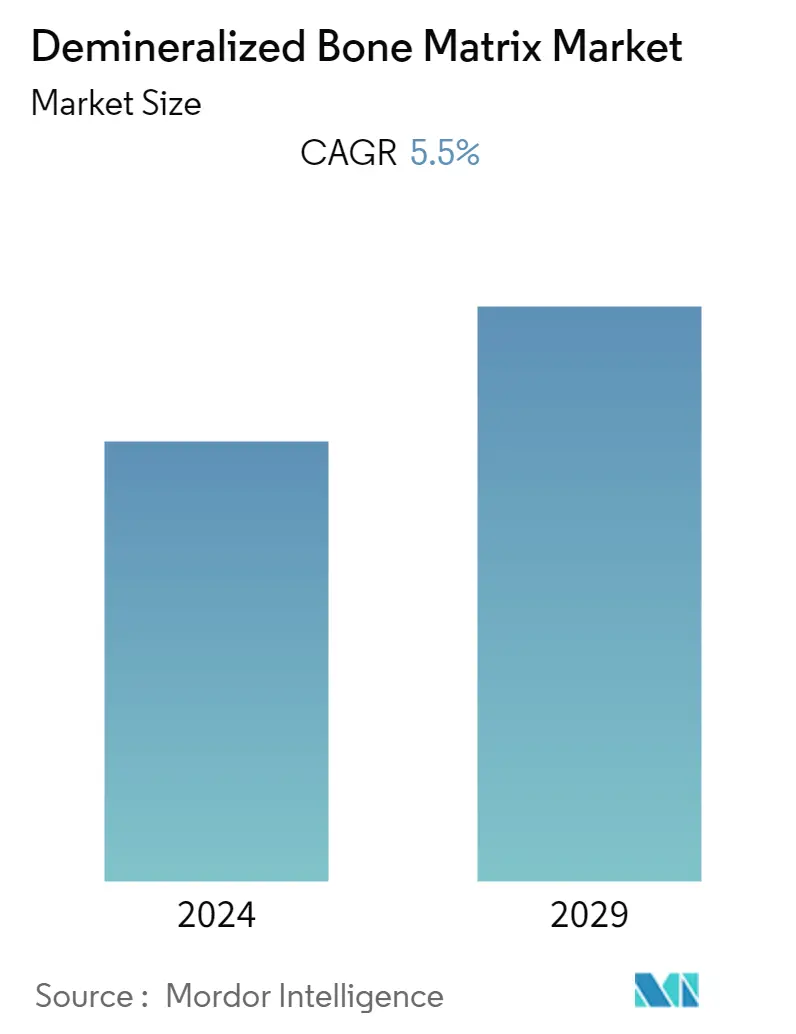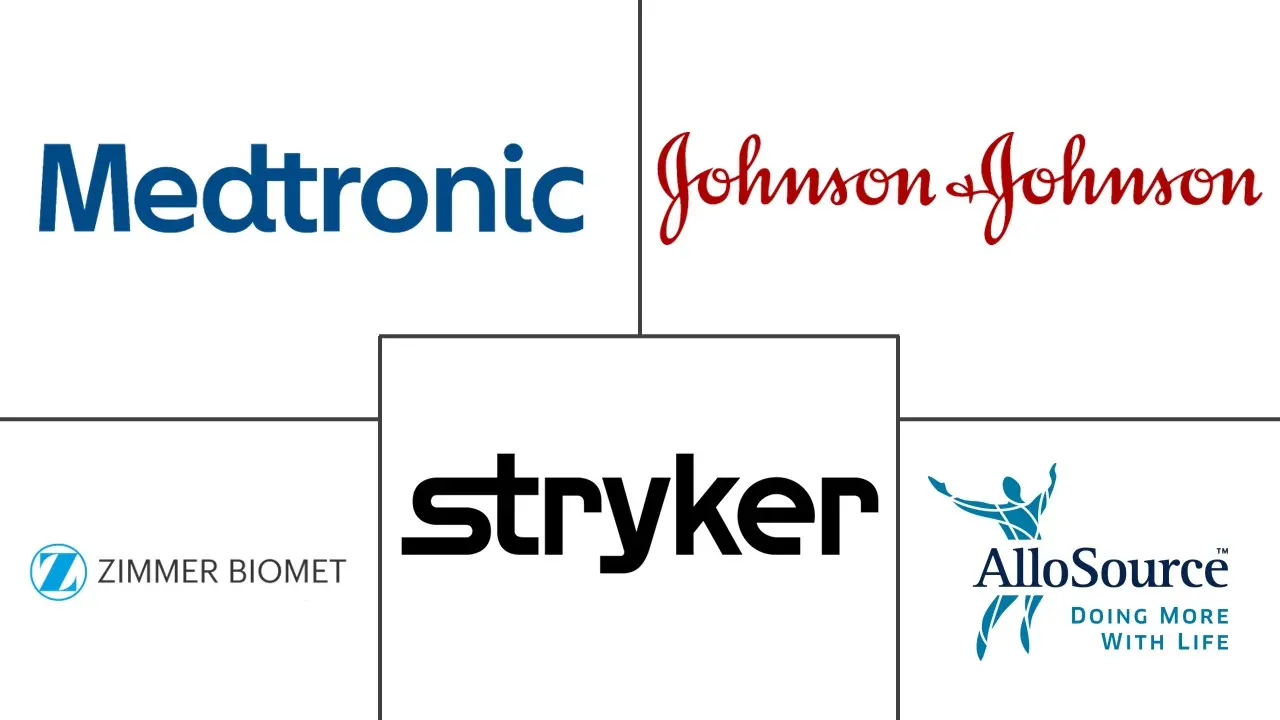Market Size of Demineralized Bone Matrix Industry

| Study Period | 2019 - 2029 |
| Base Year For Estimation | 2023 |
| CAGR | 5.50 % |
| Fastest Growing Market | Asia Pacific |
| Largest Market | North America |
| Market Concentration | Low |
Major Players
*Disclaimer: Major Players sorted in no particular order |
Demineralized Bone Matrix Market Analysis
The demineralized bone matrix market is expected to register a CAGR of 5.5% over the forecast period.
Delays in orthopedic care and services during the COVID-19 pandemic adversely impacted the market. According to the NCBI research study published in August 2021, orthopedic residency training was postponed or canceled during the pandemic. The inevitable halting of all elective surgeries has limited hands-on practice and exposure to several procedures. Although the orthopedic oncology service has continued, it is a limited area within the orthopedic training program, including at least nine sub-specialties. Trauma surgery continued but at a much slower rate, most likely due to the nationwide lockdown, which had a short-term negative impact on the market. In March 2020, the International Olympic Committee postponed the 2020 Tokyo Olympics and Paralympics to 2021. According to the CovidSurg Collaborative, a research initiative by 120 countries, 28.4 million elective surgeries were reported to have been canceled in 2020, including 6.3 million orthopedic surgeries. However, with a decrease in the number of cases of COVID-19 and the resumption of various healthcare services, the market gained traction and is anticipated to continue its upward trend over the forecast period.
Factors such as the increasing incidence of orthopedic disorders, the rising number of spinal fusion and dental surgeries, and the increasing patient base with a growing population are expected to drive the market's growth. For instance, according to the WHO Key Facts on Musculoskeletal Health published in July 2022, around 1.71 billion people worldwide had musculoskeletal conditions. In Europe, the International Osteoporosis Foundation (IOF) is responsible for raising awareness of osteoporosis care in Europe. According to an article published by the National Institute of Health, in 2021, the incidence of osteoarthritis in the United Kingdom was 6.8 per 1,000 people, whereas the prevalence was around 10.7% in 2021. Thus, such a high prevalence of orthopedic disorders is expected to propel the demand for demineralized bone matrix, as it one of the important therapeutic options for such conditions.
As per the Australian Institute of Health and Welfare's article on chronic musculoskeletal conditions published in July 2022, around 6.9 million people in Australia were affected by musculoskeletal disorders during 2020-2021. Over 3.1 million people had arthritis, and more than 889 thousand people had osteoporosis. According to the US CDC article on arthritis, updated in October 2021, around 58.5 million people in the nation had doctor-diagnosed arthritis. The article estimated that, by 2040, over 78.4 million adults in the United States will be affected by arthritis. Thus, owing to such factors, considerable market growth is expected over the forecast period.
However, the high cost of demineralized bone matrix is expected to hinder the market's growth over the forecast period.
Demineralized Bone Matrix Industry Segmentation
As per the scope of the report, a demineralized bone matrix (DBM) is an osteoconductive scaffold that is manufactured by acid extraction of allograft bone resulting in the retention of collagen and non-collagenous proteins, including growth factors. These components make DBM both osteoinductive and osteoconductive.
The demineralized bone matrix market is segmented by product type (gel, putty, and other product types), application (dental, craniomaxillofacial, joint reconstruction, spinal fusion, and other applications), geography (North America, Europe, Asia-Pacific, and Rest of the World). The report offers the value (in USD million) for the above segments.
| By Product Type | |
| Gel | |
| Putty | |
| Other Product Types |
| By Application | |
| Dental | |
| Craniomaxillofacial | |
| Joint Reconstruction | |
| Spinal Fusion | |
| Other Applications |
| By Geography | ||||||||
| ||||||||
| ||||||||
| ||||||||
| Rest of the World |
Demineralized Bone Matrix Market Size Summary
The demineralized bone matrix market is poised for growth, driven by an increasing incidence of orthopedic disorders and a rising number of spinal fusion and dental surgeries. The market experienced a temporary setback due to delays in orthopedic care and services during the COVID-19 pandemic, which led to the postponement of elective surgeries and limited hands-on practice in orthopedic training. However, as healthcare services resumed, the market began to recover and is expected to continue its upward trajectory. The growing patient base, fueled by an expanding global population and a significant prevalence of musculoskeletal conditions, is anticipated to further propel market growth. Despite the high cost of demineralized bone matrix products posing a challenge, the demand for these therapeutic options remains strong, particularly in regions with a high incidence of orthopedic disorders.
North America is expected to witness substantial growth in the demineralized bone matrix market, driven by the increasing prevalence of spinal injuries, orthopedic disorders, and a rising geriatric population. The region's market growth is supported by key product launches, a high concentration of market players, and an increasing number of spine surgeries. The competitive landscape is characterized by price competition, product differentiation, and a focus on innovative product development, with major industry players such as Johnson & Johnson (Depuy Synthes), Medtronic, AlloSource, Zimmer Biomet, and Stryker leading the charge. Recent product launches, such as Paragon 28 Inc.'s V92-FC+ Cellular Bone Matrix and Ossifix Orthopedics' demineralized bone matrix, highlight the ongoing innovation within the market. As the demand for spinal fusion surgeries and other orthopedic procedures continues to rise, the market is expected to experience significant growth over the forecast period.
Demineralized Bone Matrix Market Size - Table of Contents
-
1. MARKET DYNAMICS
-
1.1 Market Overview
-
1.2 Market Drivers
-
1.2.1 Rising Incidence of Orthopedic Disorders
-
1.2.2 Increasing Number of Spinal Fusion and Dental Surgeries
-
1.2.3 Increasing Patient Base with Growing Population
-
-
1.3 Market Restraints
-
1.3.1 High Cost of Demineralized Bone Matrix
-
-
1.4 Porter's Five Forces Analysis
-
1.4.1 Threat of New Entrants
-
1.4.2 Bargaining Power of Buyers/Consumers
-
1.4.3 Bargaining Power of Suppliers
-
1.4.4 Threat of Substitute Products
-
1.4.5 Intensity of Competitive Rivalry
-
-
-
2. MARKET SEGMENTATION (Market Size by Value - USD million)
-
2.1 By Product Type
-
2.1.1 Gel
-
2.1.2 Putty
-
2.1.3 Other Product Types
-
-
2.2 By Application
-
2.2.1 Dental
-
2.2.2 Craniomaxillofacial
-
2.2.3 Joint Reconstruction
-
2.2.4 Spinal Fusion
-
2.2.5 Other Applications
-
-
2.3 By Geography
-
2.3.1 North America
-
2.3.1.1 United States
-
2.3.1.2 Canada
-
2.3.1.3 Mexico
-
-
2.3.2 Europe
-
2.3.2.1 Germany
-
2.3.2.2 United Kingdom
-
2.3.2.3 France
-
2.3.2.4 Italy
-
2.3.2.5 Spain
-
2.3.2.6 Rest of Europe
-
-
2.3.3 Asia-Pacific
-
2.3.3.1 China
-
2.3.3.2 Japan
-
2.3.3.3 India
-
2.3.3.4 Australia
-
2.3.3.5 South Korea
-
2.3.3.6 Rest of Asia-Pacific
-
-
2.3.4 Rest of the World
-
-
Demineralized Bone Matrix Market Size FAQs
What is the current Demineralized Bone Matrix Market size?
The Demineralized Bone Matrix Market is projected to register a CAGR of 5.5% during the forecast period (2024-2029)
Who are the key players in Demineralized Bone Matrix Market?
Medtronic, Stryker, Johnson & Johnson (Depuy Synthes), AlloSource and Zimmer Biomet are the major companies operating in the Demineralized Bone Matrix Market.

